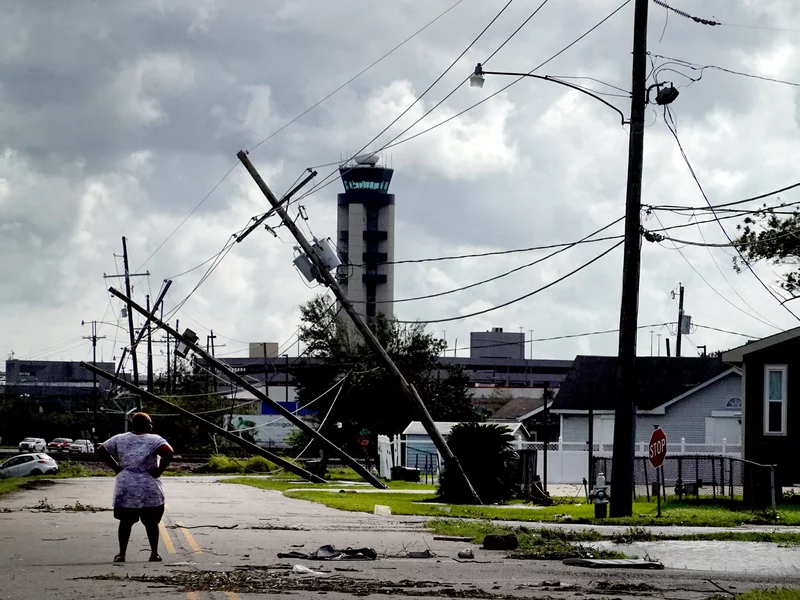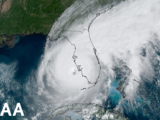
A woman surveys damage Monday from Hurricane Ida in a neighborhood in Kenner, La. The storm was fueled by abnormally warm water in the Gulf of Mexico:
Scott Olson/Getty Images
Staff Report –
Hurricane Ida’s deadly and destructive siege of wind and flooding from Louisiana to the Northeast virtually guarantees the retirement of that name from future use.
Atlantic tropical storm and hurricane name lists repeat every six years unless a storm is so severe that the name is retired from future lists. This avoids any confusion or insensitivity over the use of, say, Harvey, Katrina, Maria or Sandy to describe another future storm.
It’s safe to say Ida will never be used for a future Atlantic named storm after what we’ve just witnessed, according to the National Weather Service.
Gulf Coast Impact
Hurricane Ida pummeled southeast Louisiana with storm surge possibly over 10 feet in some areas and up to 16 inches of rain. Several Louisiana towns were inundated, including Grand Isle, Jean Lafitte, Braithwaite, LaPlace and areas near the lakeshore in New Orleans.
Ida produced wind gusts over 100 mph, including a 172 mph gust on a ship in Port Fourchon that was among the nation’s strongest measured wind gusts from a hurricane. Gusts from 90 to 100 mph hammered the New Orleans metro area.
These winds downed all eight transmission lines supplying electricity to New Orleans. Power outages in Louisiana, alone, topped 1 million, and hundreds of thousands were without running water.
Northeast Impact
The punch Ida gave the northern Gulf Coast, alone, might have been enough to merit retiring the name. But Ida was about to put the exclamation point on that in the Northeast.
Despite being designated a tropical depression, Ida’s circulation combined with a previously-stalled front to wring out prolific rain in the Mid-Atlantic and Northeast three days after its Louisiana landfall.
Up to 11 inches of rain swamped parts of Pennsylvania, Delaware, New Jersey, New York and southern New England.
Rain fell at just over 3 inches per hour at New York City’s Central Park, an all-time record dating to 1869. Newark, New Jersey, had its wettest single day in 90 years (8.41 inches).
At least 11 locations set all-time river flood crest records, some of which topped crests set during Hurricane Irene (2011), Floyd (1999) or Agnes (1972), all retired hurricanes.
After the rain ended, lingering flooding left parts of New Jersey unrecognizable.
In Philadelphia, the Schuylkill River reached its highest level in almost 152 years, prompting evacuations in some areas.
As of the time this article was published, the death toll in both the Northeast and northern Gulf Coast had reached 44, as crews worked to get into flooded areas to assess the damage and begin restoring power.
A number of New York City residents apparently died in flooded basements and hundreds were rescued not only in the NYC Tri-State, but also in Wilmington, Delaware, among other locations.
Runways at Newark-Liberty and Teterboro Airports in northern New Jersey were flooded.
Destructive tornadoes tore through Annapolis, Maryland; Mullica Hill, New Jersey; and other parts of the Delaware Valley north and south of Trenton, New Jersey.
The Mullica Hill, New Jersey, tornado was the first to be rated at least F/EF3 in the state since Oct. 18, 1990, according to NOAA’s database. Tornadoes that strong are particularly rare in tropical cyclones and their remnants, but these are times of great climate change, with global warming fueling more violent storms and unpredictable weather.
While it’s too soon for more precise damage figures, Ida appeared likely to be directly responsible for at least double-digit billion-dollar damage and losses according to Steve Bowen, meteorologist at Aon. And that estimate was made before the Northeast flood.
Ida could even crack the top 10 list of America’s costliest hurricanes by the time the figures are in.
This combination of damage and deaths should make retiring “Ida” a straightforward decision when a committee of the World Meteorological Organization meets in March to consider name retirements from the 2021 hurricane season.
Last March, this WMO committee voted to retire Laura, Dorian, and the entire Greek alphabet from future use as tropical storm or hurricane names.
Names beginning with the letter “I” have been retired most often, since these ninth named storms of a season tend to form in the most active months of hurricane seasons, when conditions are most favorable for stronger hurricanes that could have significant impact.
“Ida” replaced “Isabel” in the name list after that hurricane ravaged the Mid-Atlantic, including the Washington, D.C. metro area, in 2003 and was subsequently retired.
Power Restoration and Death
Power is expected to be restored to most of New Orleans by next Wednesday, but harder-hit areas could wait a month or more for electricity. That was the word Friday from power company officials and those in local parishes, according to the Weather Channel.
The update comes as Ida’s death toll continues to rise amid sweltering heat and miserable conditions. The 9 casualties in Louisiana so far include at least three people who died from carbon monoxide poisoning Thursday in Jefferson Parish. Dozens more have been taken to hospitals.
At least four nursing home residents are also among the dead, after hundreds were evacuated following Ida.
A timeline released Friday morning by Entergy, the state’s largest electricity provider, estimated that power would be restored sometime between now and Wednesday for residents in several areas, including New Orleans and parts of Ascension, St. Bernard, Plaquemines and Jefferson parishes.
The timeline didn’t include places like St. Charles Parish to the west of New Orleans, where officials were telling residents not to expect power for 4 to 6 weeks. St. Charles alone has more than 2,820 broken poles and 617 damaged transformers.
President Biden was scheduled to visit LaPlace after he landed in New Orleans on Friday.
FEMA has approved Louisiana for a federal program that pays for hotel stays for up to 30 days for those whose homes are unlivable. Those interested should register at www.disasterassistance.gov or by calling 1-800-621-3362.
Many of those who can afford it have relocated to hotels in other areas, including Jackson, Mississippi.
“To me, it’s traumatic, and I’ve really been praying about it, but I don’t know if I want to go back home,” evacuee Jeanette White told WJTV. “As much as I love New Orleans, I’m just getting tired of running from hurricanes.”
New Orleans Evacuation
Nearly a week after Hurricane Ida slammed into the Gulf Coast, leaving behind extensive power outages and escalating despair, this city began evacuating some residents in an effort to give them a respite from the punishing heat, according to The Washington Post.
Authorities said the evacuations, which began Friday, are voluntary and aimed at helping the city’s most vulnerable. On the same day, utility officials laid out a timeline for returning power to storm-battered areas, including across greater New Orleans by the middle of next week.
“Even as power is being restored, and we’re seeing steps towards that, we do recognize that not everyone has it,” New Orleans Mayor LaToya Cantrell said Friday afternoon. “The stressors are remaining.”
Ida’s fallout continues to reverberate across various regions of the country, leaving people scrambling for essentials like groceries and fuel. In the Northeast, where Ida’s remnants unleashed devastating rains and killed dozens of people across four states, elected leaders said that they expected the death toll to rise and would review how officials prepared. In Louisiana, President Biden toured the devastated areas on Friday and acknowledged the frustration residents felt waiting for power to return.
Hours-long gas lines have stretched through the area, as people seek fuel for their cars and generators. The search for fuel sent some from Louisiana over the state line into Mississippi, to places like Picayune and Poplarville, where the power was on and gas was flowing.
Louisiana officials say three evacuated nursing home residents among storm’s victims as region struggles with heat and outages
Scores of people gathered outside the center on Friday to grab free meals and water. Some took seats inside parked city buses that served as mobile cooling centers.
In parts of New Orleans, numerous streets were still blocked, as dozens of workers sought to untangle power lines from downed trees and raise fresh electrical poles — replacing equipment that was snapped by Ida’s winds.
The utility company warned that it might take longer for power to come back in certain cases, and pledged to “continue working until every community is restored.” Entergy Mississippi, meanwhile, said it expected most customers impacted by Ida and then a midweek rainstorm to have power back by Friday night.
Cantrell, the New Orleans mayor, said the evacuations began Friday with special-needs residents, seniors and other vulnerable people who wanted to leave the city until power returns and head to state-run shelters elsewhere in Louisiana and places including Texas.
“I am cautiously optimistic that the timeline that has been provided by Entergy will be complete by those deadlines, but . . . I am expecting more sooner rather than later,” she said.
Beginning Saturday, she said, the rest of the New Orleans population could begin evacuating on the buses. Collin Arnold, director of the New Orleans Office of Homeland Security and Emergency Preparedness, said the evacuations were primarily aimed at “the people that really are vulnerable to heat and really need this,” asking others leave space for people who “might need it more.”
Elsewhere in Louisiana, officials said they were still investigating the deaths of vulnerable residents in the state — three nursing home residents who died after being evacuated.













